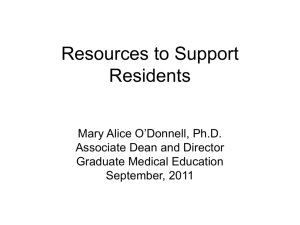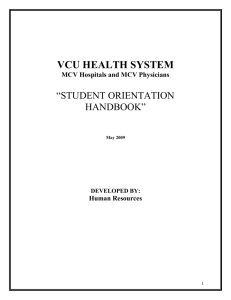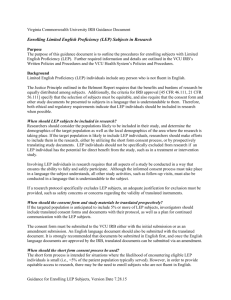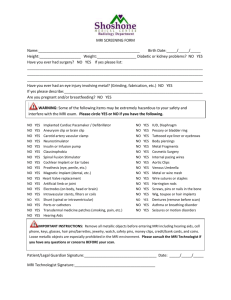MRI Safety - VCU Department of Pediatrics
advertisement
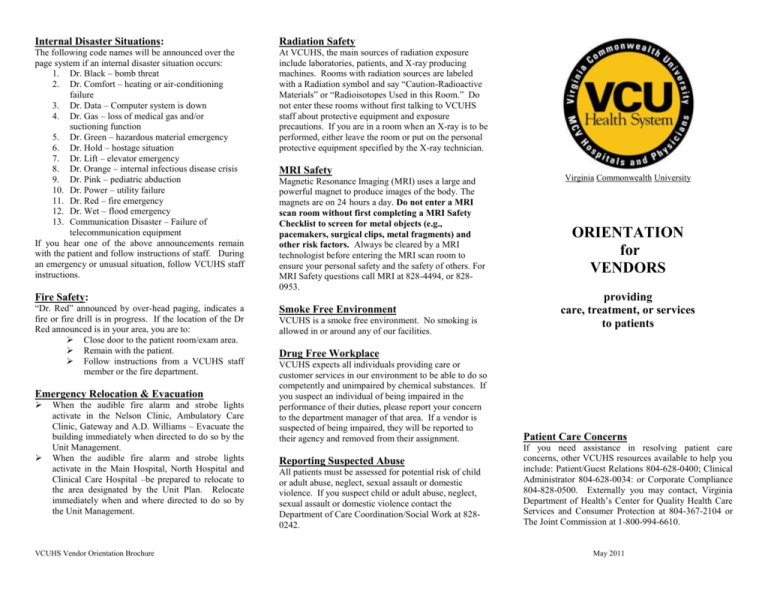
Internal Disaster Situations: Radiation Safety The following code names will be announced over the page system if an internal disaster situation occurs: 1. Dr. Black – bomb threat 2. Dr. Comfort – heating or air-conditioning failure 3. Dr. Data – Computer system is down 4. Dr. Gas – loss of medical gas and/or suctioning function 5. Dr. Green – hazardous material emergency 6. Dr. Hold – hostage situation 7. Dr. Lift – elevator emergency 8. Dr. Orange – internal infectious disease crisis 9. Dr. Pink – pediatric abduction 10. Dr. Power – utility failure 11. Dr. Red – fire emergency 12. Dr. Wet – flood emergency 13. Communication Disaster – Failure of telecommunication equipment If you hear one of the above announcements remain with the patient and follow instructions of staff. During an emergency or unusual situation, follow VCUHS staff instructions. At VCUHS, the main sources of radiation exposure include laboratories, patients, and X-ray producing machines. Rooms with radiation sources are labeled with a Radiation symbol and say “Caution-Radioactive Materials” or “Radioisotopes Used in this Room.” Do not enter these rooms without first talking to VCUHS staff about protective equipment and exposure precautions. If you are in a room when an X-ray is to be performed, either leave the room or put on the personal protective equipment specified by the X-ray technician. MRI Safety Magnetic Resonance Imaging (MRI) uses a large and powerful magnet to produce images of the body. The magnets are on 24 hours a day. Do not enter a MRI scan room without first completing a MRI Safety Checklist to screen for metal objects (e.g., pacemakers, surgical clips, metal fragments) and other risk factors. Always be cleared by a MRI technologist before entering the MRI scan room to ensure your personal safety and the safety of others. For MRI Safety questions call MRI at 828-4494, or 8280953. Fire Safety: “Dr. Red” announced by over-head paging, indicates a fire or fire drill is in progress. If the location of the Dr Red announced is in your area, you are to: Close door to the patient room/exam area. Remain with the patient. Follow instructions from a VCUHS staff member or the fire department. Emergency Relocation & Evacuation When the audible fire alarm and strobe lights activate in the Nelson Clinic, Ambulatory Care Clinic, Gateway and A.D. Williams – Evacuate the building immediately when directed to do so by the Unit Management. When the audible fire alarm and strobe lights activate in the Main Hospital, North Hospital and Clinical Care Hospital –be prepared to relocate to the area designated by the Unit Plan. Relocate immediately when and where directed to do so by the Unit Management. VCUHS Vendor Orientation Brochure Smoke Free Environment VCUHS is a smoke free environment. No smoking is allowed in or around any of our facilities. Virginia Commonwealth University ORIENTATION for VENDORS providing care, treatment, or services to patients Drug Free Workplace VCUHS expects all individuals providing care or customer services in our environment to be able to do so competently and unimpaired by chemical substances. If you suspect an individual of being impaired in the performance of their duties, please report your concern to the department manager of that area. If a vendor is suspected of being impaired, they will be reported to their agency and removed from their assignment. Reporting Suspected Abuse All patients must be assessed for potential risk of child or adult abuse, neglect, sexual assault or domestic violence. If you suspect child or adult abuse, neglect, sexual assault or domestic violence contact the Department of Care Coordination/Social Work at 8280242. Patient Care Concerns If you need assistance in resolving patient care concerns, other VCUHS resources available to help you include: Patient/Guest Relations 804-628-0400; Clinical Administrator 804-628-0034: or Corporate Compliance 804-828-0500. Externally you may contact, Virginia Department of Health’s Center for Quality Health Care Services and Consumer Protection at 804-367-2104 or The Joint Commission at 1-800-994-6610. May 2011 Introduction Confidentiality Welcome to VCU Health System. Though you are employed by someone else, you are here at this time to provide care, treatment, or services to one of our patients. While you are here, there are practices that you need to know to support your own safety as well as the safety of our patients. This brochure is designed to explain our expectations for you while you are here and to identify resources that may be of assistance. While here you may become aware of confidential medical information. Disclosure of confidential health information to any other person, or allowing any other person access to, any information related to VCUHS which is proprietary or confidential and/or pertains to employees, patients or patient care is strictly prohibited. Reptrax Participation As a vendor who provides services that affect patient care, you are required to participate as a Reptrax member and to keep your profile active and current. Obtain a Reptrax ID badge upon arrival in Gateway lobby and display when providing services at VCUHS. Competency Prior to providing direct patient services, VCUHS will need to confirm through Reptrax that you have the required credentials to perform the duties expected. In addition, a representative from VCUHS will observe your performance to determine if the knowledge, skills, and abilities you display support that you are competent to provide patient service. If there is a concern regarding competency, you will not be allowed to independently provide patient treatment or care. Staff Identification Badges All staff should be wearing a VCUHS issued identification badge that will assist you in knowing who they are, their job at VCUHS, and how they might assist you. Patient Identification It is essential that before you provide any patient care or treatment that you make sure you have the correct patient. At VCUHS we use two patient identifiers. For inpatients, we use the patient name and medical record number. For outpatients, we use the patient name and date of birth. Always confirm you have the correct patient before proceeding with any type of service. Changes in Patient Condition If you observe what you perceive to be a decline in the patient's condition, notify nursing staff immediately. Remain with patient until help arrives and then follow instructions. Customer Service Expectations We expect everyone who represents our organization, to treat those with whom they interact with respect, courtesy and caring. VCUHS strives to provide equal opportunities, services, and access to all persons without regard to race, color, religion, gender, age, national origin, disability, or veteran’s status. If you have difficulty communicating with a patient due to language differences, contact the Office of Language Services (628-1116) or ask a staff member for assistance in using the language interpretative services phone. Patient Rights and Responsibilities Patients are entitled to certain rights. We affirm the Patient Bill of Rights and Responsibilities posted throughout our organization and all persons serving our organization are expected to support and respect these principles. VCUHS Vendor Orientation Brochure Patient Falls VCUHS’ fall precaution program identifies patients with a high probability of falling by placing an orange sticker on the patient’s door and giving the patient a special identification band. If the patient you are seeing is identified in this way, do not let the patient out of bed unassisted. Call the nursing staff for assistance. Precautions for patients who are at risk for falls: Upper bed side-rails should remain in an upright position and the bed should remain at its lowest height. If the patient attempts to climb over side-rails, notify a staff member immediately, remain with the patient, and maintain patient safety/security while waiting for staff. If you observe a patient fall, do not attempt to move the patient. Call for help and remain with the patient. Infection Control Instructions To protect yourself and the patient: Wash hands for 15 seconds before and after contact with patient. Foam soap located outside patient rooms may also be used. Wear a gown and gloves with any potential contact with blood and/or body fluids. Gloves do not replace hand washing! Hands should be washed after removing gloves. If further precautions are needed, VCUHS staff will provide additional instructions. Respiratory Protection In some areas, respirators (masks) are necessary to protect you from harmful dusts, fibers, fumes, mists, gases, or vapors. Individuals who wear respiratory protection must be fit-tested to determine if the respirator is providing an effective barrier. Persons, who may be exposed to tuberculosis, must be fit-tested for a specific (N-95) mask prior to entering a room where possible exposure could occur. Infectious Waste Materials contaminated with blood or body fluids must be discarded properly. Always use standard precautions when handling infectious or medical waste. Use red or orange bags to dispose of infectious waste materials. Place infectious sharps in a red, biohazard labeled, plastic sharps container that is no more than ¾ full. Do not mix non-infectious sharps with infectious sharps. Chemotherapeutic Waste Chemotherapeutic sharps and items visibly contaminated with chemotherapeutic agents are to be placed in black containers. Items used with chemotherapeutic agents but not soiled are to be placed in yellow bags. May 2011

